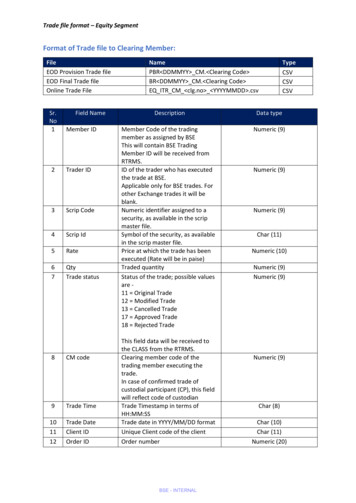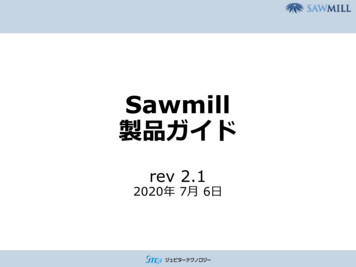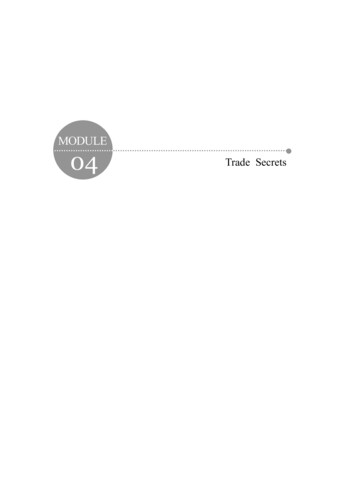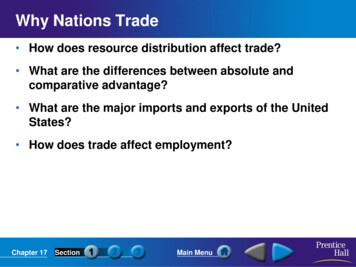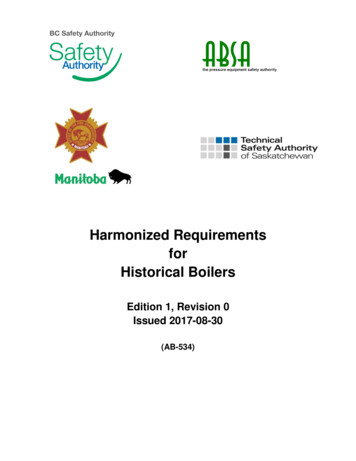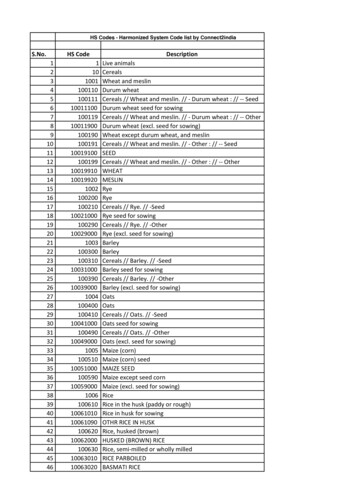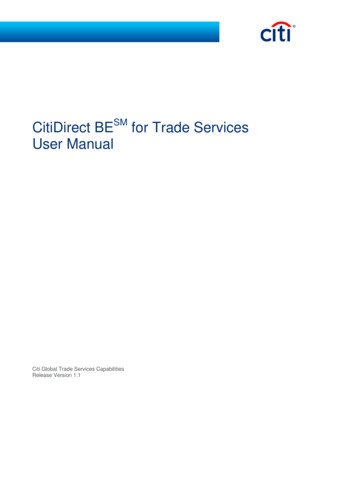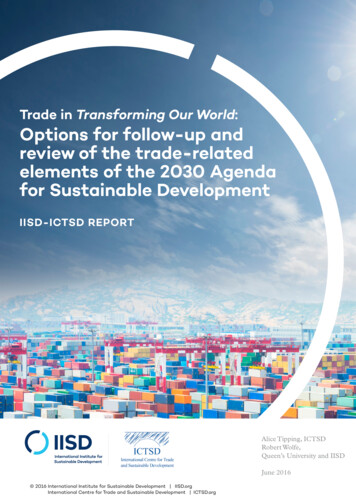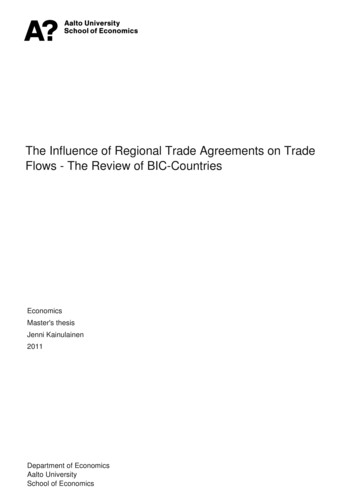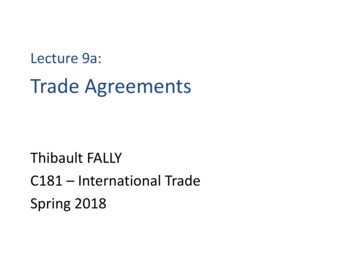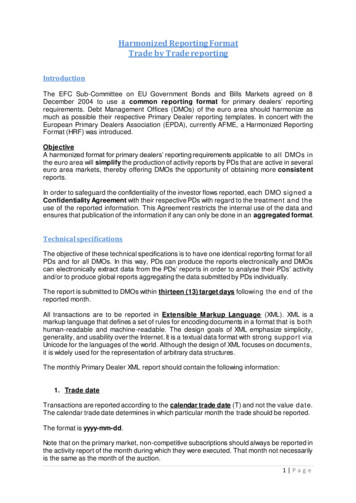
Transcription
Harmonized Reporting FormatTrade by Trade reportingIntroductionThe EFC Sub-Committee on EU Government Bonds and Bills Markets agreed on 8December 2004 to use a common reporting format for primary dealers’ reportingrequirements. Debt Management Offices (DMOs) of the euro area should harmonize asmuch as possible their respective Primary Dealer reporting templates. In concert with theEuropean Primary Dealers Association (EPDA), currently AFME, a Harmonized ReportingFormat (HRF) was introduced.ObjectiveA harmonized format for primary dealers’ reporting requirements applicable to all DMOs inthe euro area will simplify the production of activity reports by PDs that are active in severaleuro area markets, thereby offering DMOs the opportunity of obtaining more consistentreports.In order to safeguard the confidentiality of the investor flows reported, each DMO signed aConfidentiality Agreement with their respective PDs with regard to the treatment and theuse of the reported information. This Agreement restricts the internal use of the data andensures that publication of the information if any can only be done in an aggregated format.Technical specificationsThe objective of these technical specifications is to have one identical reporting format for allPDs and for all DMOs. In this way, PDs can produce the reports electronically and DMOscan electronically extract data from the PDs’ reports in order to analyse their PDs’ activityand/or to produce global reports aggregating the data submitted by PDs individually.The report is submitted to DMOs within thirteen (13) target days following the end of thereported month.All transactions are to be reported in Extensible Markup Language (XML). XML is amarkup language that defines a set of rules for encoding documents in a format that is bothhuman-readable and machine-readable. The design goals of XML emphasize simplicity,generality, and usability over the Internet. It is a textual data format with strong support viaUnicode for the languages of the world. Although the design of XML focuses on documents,it is widely used for the representation of arbitrary data structures.The monthly Primary Dealer XML report should contain the following information:1. Trade dateTransactions are reported according to the calendar trade date (T) and not the value date.The calendar trade date determines in which particular month the trade should be reported.The format is yyyy-mm-dd.Note that on the primary market, non-competitive subscriptions should always be reported inthe activity report of the month during which they were executed. That month not necessarilyis the same as the month of the auction.1 Pa g e
E.g. bonds bought at the auction of 29 April, must be reported in the April HRF. Howevernon-competitive subscriptions that are executed on 3 May and on 6 May should be reportedin the May HRF.2. SecurityThe ISIN code determines whether or not a transaction is reportable.Non-reportable securities that are accidentally reported, will automatically be deleted fromthe report by the DMOs.In other words the PDs do not have to determine the security type.3. Transaction type and reportable transactionsAs regards the transaction type there are two 2 options:- B (i.e. Buy)- S (i.e. Sell)The transaction type should always be reported from the Primary Dealer ’s perspective; i.e.:- “B” is a Primary Dealer buying from a counterpart, and;- “S” is a Primary Dealer selling to a counterpart.Only outright purchases and sales are reportable, irrespective the number o f tr ad ingdays that lay between the trade date and the value date . All are reportable with theexception of transactions with central banks that are executed within the framework of theirmonetary policy (i.e. PSPP and PEPP).The sale by a PD of a bond to a DMO in the framework of a buy back operation beforematurity should be reported as “S” (sale to DMO). The redemption is done before thematurity of the bond ( it is not a redemption at maturity that should not be reported). T hetrade is an outright sale ( it is not a sell and a buy back).Repos, buy and sell back, bond stripping and reconstitution (even when done for account ofa third party), bond redemptions at maturity (or upon the exercise of a call by the relevantDMO in the case of a callable bond) should not be reported.Strips: Stripping and reconstitution operations should not be reported. All secondary marketactivity should be reported.2 Pa g e
4. QuantityThe turnover to be reported is the nominal value , expressed in units and no roundingshould be made.The maximum number of decimals that can be used is 2. The decimal separator is a point “.”No 1000 separator can be used.E.g. a transaction is reported 10750000.00 and not 10.75.5. CounterpartAs regards counterpart types, the following numbering should be used in the XML format:1 Inter Dealer Broker3 Bank-Primary Dealer4 Bank-Inter Dealer5 Bank-Connected Entity6 Bank-Customer7 Debt Management Office8 Public Entity9 Pension Fund10 Insurance Company11 Fund Manager12 Hedge Fund13 Retail14 CorporateThe list of counterpart types and the counterpart definitions is attached to this document(Annex 1 - Counterpart Definitions).The code “2” is left out upon request of the Primary Dealers as it refers to the counterparttype “Bank-Own Account” that has become obsolete since January 2012.6. CountryFor each individual transaction, the country of incorporation of the counterpart should bereported using the ISO 3166-1 alpha 3 code (Annex 2 – ISO Country Codes).The counterpart's location is determined by the country in which it has been legallyincorporated. For branches, the counterpart location is determined by the country ofincorporation of its head office.To the above rule the following exception is made: whenever the counterpart is an Asianpublic entity, the Primary Dealers can opt to report not the Asian country but one of thefollowing 5 geographical regions: West Asia, Central Asia, East Asia, South Asia or Far EastAsia (Annex 3 – Country codes for Asian public entities).7.SystemAs regards trading systems, the following numbering should be used in the XML format:1 BGC Brokers - eSpeed3 Pa g e
2 BrokerTec3 Bloomberg4 Eurex Bonds5 EuroMTS6 HDAT7 Local MTS8 Reuters9 SENAF10 Bondvision11 Tradeweb12 MarketAxess13 Other Electronic14 Non ElectronicNotes:- From 2006 until 2013, a sale to the DMO within the framework of a buy backoperation before maturity had to be reported as non-electronic; even when done onan e-trading platform (e.g. the Belgian Debt Agency buying back bonds on MTSBelgium). Since 2014, this anomaly is lifted and the actual e-trading platform must bereported if the buyback took place on an e-trading platform.- Some e-trading platforms offer a facility to handle the processing of an OTCtransaction on their system. Such transactions should be reported as “14” (NonElectronic). Reason: the trading system was only used for STP (Straight ThroughProcessing) reasons whilst the transaction itself was initially not generated on thesystem.8. Value dateThe reporting format of the value date is yyyy-mm-dd.According to item 1. above, transactions are reported according to the calendar trade date(T). The calendar trade date determines in which particular month the trade should bereported.E.g. a transaction with trade date 2020-01-31 and value date 2020-02-04 (or later), must bereported in the January HRF.4 Pa g e
Annex 1 – Counterpart DefinitionsCOUNTERPART TYPES OF THE REPORTING PRIMARY DEALERS iCODE CAPTIONDESCRIPTIONDEALERii1Inter Dealer BrokeriiiTrades between the Reporting PD and a non-bank regulatedfinancial intermediary, including central counterpart, electronicand voice brokerage, on a non-name give up basis (i.e. the InterDealer Broker does not disclose the name of the counterpart).3Bank-Primary Dealer(i) Trades between the Reporting PD and another PD iv appointedby the same DMO as the Reporting PD.(ii) trades between the Reporting PD and Recognized Dealers orSingle Market Specialists (the latter only for the type ofsecurity(ies) that they have been appointed to trade) appointedby the same DMO as the Reporting PD.4Bank-Inter DealerTrades between the Reporting PD and a bank that has a PD-shipin at least 3 countriesv of the euro area (inclusive Denmark) andthat is not reportable under item 3.CUSTOMERvi5Bank-Connected Entity(i) Trades between the Reporting PD and a Company belonging tothe same group of Companiesvii as the Reporting PD, unless thetrade is reportable under items 9-14viii.(ii) Trades between the Reporting PD and the ALM department ixof the bank of which the Reporting PD is a part of, or between theReporting PD and a segregated proprietary trading unit x of thebank of which the Reporting PD is a part ofxi.6Bank — Customer(i) Trades between the Reporting PD and a bank that has a PDshipin less than 3 countries of the euro area (inclusive Denmark),unless the trade is reportable under item 13.(ii) Trades between the Reporting PD and the ALM department ofanother PD.7Debt Management OfficeTrades between the Reporting PD and the DMO that hasappointed it xii.8Public EntityTrades between the Reporting PD and all public entities acting asfund managers. Includes trades with central banks, sovereignswealth funds and supranational institutions unless such tradescan be reported under items 9, 10 or 14.5 Pa g e
Transactions with central banks:- only transactions executed within the framework of theirinvestment portfolio should be reported- transactions executed within the framework of their monetarypolicy should NOT be reported9Pension FundTrades between the Reporting PD and private or governmentpension funds.10Insurance CompanyTrades between the Reporting PD and (re-)insurance companies.This includes their integrated insurance/pension fund managersunless clearly identifiable as "pension fund" under item 9.11Fund ManagerTrades between the Reporting PD and fund managers includinginvestments funds e.g., asset management companies, mutualfunds, real estate investment companies, and foundations.12Hedge FundTrades between the Reporting PD and hedge fundsxiii whereidentifiable, otherwise reported under item 11.13RetailTrades between the Reporting PD and private client banksxiv andprivate client division of the reporting PD and agency brokers orindividuals if applicable.14CorporateTrades between the Reporting PD and commercial, industrial &holding companies and their financial subsidiaries as part of theirinvestment activities, unless reported under item 9, 10, 11 or 12.NOTESiThe issue is whether the activity report should contain only the trades transacted by the EuropeanGovernment bonds desk of the reporting PD or whether the activity report should als o in clu de t h e t radestransacted by other trading units of the reporting PD (e.g., options or prop desk, a branch or a subsidiary)The set of rules rests on the following two principles:(i) The concept of “reporting PD” encompasses all its internal trading units.This includes the Government bond, back book, primary, swap, option, credit and non -segregatedproprietary trading desks.This excludes the ALM department, the segregated proprietary trading desks and the “connectedentities” (such as a branch or a subsidiary) of the reporting PD., which are considered to be “ext ernal”trading units(ii) The trades to be reported are only the trades done by the reporting PD with the market. Th e “market ”encompasses the “external“ trading units of the reporting PD, (ALM departmen t, s egregat ed p ro pdesk , branches and subsidiaries)Correspondingly:- The trades done between two internal trading units of the reporting PD should no t b e rep o rted. Th ese“internal” trades have not been transacted with the market.- The trades done by an internal trading unit with an external trading unit (including its ALM departmen tand its segregated prop desk) should be reported. These trades are deemed to have been transacted by thereporting PD with the market.6 Pa g e
- The trades done by an external trading unit with an external counterpart should not be reported,irrespective of their counterpart. These trades are deemed not to have been transacted b y t h e rep ort ingPD.ii“Dealer”: The distinct feature of dealers is to be professional counterparts competing with the reporting PDto do business with customers.iii“Inter Dealer Broker” (IDB): the specificity of an IDB is to provide the interface between a b u yer an d aseller and to trade in its own name in order to preserve the anonymity of its clients (“blind intermediation”).If an IDB intervenes only as a transparent intermediary in between two counterparties, the trade is reportableas though it had been concluded directly between the reporting PD with its counterpart. If despite the use o fa blind intermediary, the identity of the counterpart is known nevertheless, the rep o rted cat ego ry s ho uldwhenever possible be the category applying to that counterpart.ivA list of PDships is kept up to date by AFME and published on its website. The AFME list is bas ed o n t h einformation published on the DMOs websites and is normally updated on a quarterly /primary-dealersvCfr. footnote iv above. Note that only for the Kingdom of Belgium, Recognized Dealers are assimilated withPrimary Dealers. However, these Recognized Dealers will not be indicated as “Primary Dealer” in theAFME list.viCustomer counterparts (including banks) that the Reporting PD considers to be a commercial relationship.The relationship is the result of a marketing effort and the objective of the Reporting PD is to maximize t h evolume of business with the counterpart in question. A typical (but not indispensable) feature of a cus tomerrelationship is the involvement of a Reporting PD's sales person in the trade, either direct ly (s ales p ersonassisted trade) or indirectly (the sales department earns a sales credit on the trade).viiGroup Company: a Company is considered to belong to the same group of Companies as the Report ing PDif it is a branch, subsidiary, affiliate or parent Company of the Reporting PD.In the case of a “back to back transaction” done between a Reporting PD and a Group compan y ( t rad emeant to match a trade done by i.e. a branch or subsidiary with a customer), the counterpart type and countrycorresponding to the ultimate buyer or seller of the security should be reported wh enever id en t ifiab le. Aback to back transaction is reportable only once. In the event the ultimate buyer or seller is not identifiab le,the trade is reportable under item “05 – Bank-Connected Entity”. If (i) the counterpart of the Reporting PD isa branch of the Reporting PD, and (ii) the Reporting PD has reasons to believe that the transaction is a b ackto back – e.g., because the branch is not authorized to take positions – and (iii) the ultimate counterpart is notidentifiable, then the trade should be reported under the country where the branch is es tablis hed (an d n o tunder the country of incorporation of the Parent Company).viii“Bank-Connected Entity”: this caption applies only when the trade cannot be reported under items 9 to 14.Thus, trades done by the Reporting PD with e.g., an affiliated asset management entity are reportable u nd eritem “11 – Fund Manager”.ix“ALM department” means the department that manages the balance sheet of the bank ( duration andrefinancing risks) and the bank's securities investment portfolio.xA “proprietary trading unit” is segregated when it (i) is not incorporated within the Reporting PD's tradingunits (see footnote 1 above) , (ii) does not report into the head of government bond / rates trading , an d (iii)has separate reporting lines from the Reporting PD.xiInternal trades are not reportable. This includes trades done between the government bo nd, b ack b o oks,primary, swap, option and credit trading units of the reporting PD. The Reporting PD also d o es n ot rep orttrades done by the ALM department of the bank or by its segregated proprietary trading unit(s), with acounterpart other than the Reporting PD ( trade done in the market) . The objective in this case is to av oiddouble counting if the counterpart is another Reporting PD.xii“DMO” : The trades reported under this caption(i)include all primary market transactions (auctions, taps, syndications) and buy backs;7 Pa g e
(ii)(iii)(iv)include all the amounts bought by the reporting PD in the framework of auctio n s, in clu din gnon-competitive bids. This applies also when the counterpart of the reporting PD is technicallythe Central Bank (acting as auction organizer);include only the trades done with the DMO to which the report is addressed . It s h o uld n o tinclude the trades done with other public organizations (e.g. the Central Bank);exclude final redemptions.xiii“Hedge Fund”: generally defined as speculative investment funds, including leverage funds.xiv“Private Client Bank” Reporting PD's private banking arm and institutions that hold a ban kin g licen seand the principal business of which is to manage funds held by private individuals. If eithe r of thoserequirements is not fulfilled, the counterpart is reportable under item "11 – Fund Manager". When thecustomers of the private banking division of the Reporting PD include mostly private indiv id uals b u t als osome small legal entities (corporations, schools, etc.), filtering the trades is not required. Instead, thefollowing reference to the size of the trade can be used as a rule of thumb : 100.000: retail; 100.000:corporate.8 Pa g e
Annex 2 – Country codesCountryAfghanistanAland IslandsISO Alpha-3AFGALAAlbaniaAlgeriaALBDZAAmerican SamoaAndorraAngolaASMANDAGOAnguillaAntigua and BELBLZBENBermudaBhutanBolivia, Plurinational State ofBMUBTNBOLBonaire, Sint Eustatius and SabaBosnia and HerzegovinaBESBIHBotswanaBouvet IslandBrazilBWABVTBRABritish Indian Ocean TerritoryBrunei DarussalamBulgariaIOTBRNBGRBurkina pe VerdeCayman IslandsCentral African RepublicCPVCYMCAFChadTCD9 Pa g e
ChileChina, People's Republic ofCHLCHNChristmas IslandCocos (Keeling) IslandsCXRCCKColombiaComorosCongo, Democratic Republic of theCOLCOMCODCongo, Republic ofCook IslandsCosta RicaCOGCOKCRICote ch RepublicDenmarkDjiboutiCZEDNKDJIDominicaDominican RepublicDMADOMEcuadorEgyptEl SalvadorECUEGYSLVEquatorial GuineaEritreaEstoniaGNQERIESTEthiopiaFalkland Islands (Malvinas)ETHFLKFaroe IslandsFijiFinlandFROFJIFINFranceFrench GuianaFrench PolynesiaFRAGUFPYFFrench Southern RDGuadeloupeGuamGLPGUM10 P a g e
yanaHaitiHeard Island and McDonald IslandsGUYHTIHMDHoly See (Vatican City State)HondurasHong n, Islamic Republic ofINDIDNIRNIraqIrelandIsle of JPNJEYJordanKazakhstanKenyaJORKAZKENKiribatiKorea, Democratic People's Republic ofKIRPRKKorea, Republic ofKuwaitKyrgyzstanKORKWTKGZLao People's Democratic oMacedonia, The Former Yugoslav Republic YSMDV11 P a g e
MaliMaltaMLIMLTMarshall RTMUSMYTMexicoMicronesia, Federated States ofMoldova, Republic NauruNepalNRUNPLNetherlandsNew CaledoniaNew Norfolk IslandNIUNFKNorthern Mariana IslandsNorwayOmanMNPNOROMNPakistanPalauPalestinian TerritoryPAKPLWPSEPanamaPapua New rnPolandPortugalPCNPOLPRTPuerto RicoQatarPRIQATRéunionRomaniaREUROU12 P a g e
Russian FederationRwandaRUSRWASaint BarthelemySaint Helena, Ascension and Tristan da CunhaBLMSHNSaint Kitts and NevisSaint LuciaSaint Martin (Dutch part)KNALCASXMSaint Martin (French part)Saint Pierre and MiquelonSaint Vincent and the GrenadinesMAFSPMVCTSamoaSan MarinoWSMSMRSao Tome and PrincipeSaudi ArabiaSenegalSTPSAUSENSerbiaSeychellesSierra on IslandsSomaliaSVNSLBSOMSouth AfricaSouth Georgia and the South Sandwich IslandsSouth SudanZAFSGSSSDSpainSri LankaESPLKASudanSurinameSvalbard and Jan yrian Arab RepublicTaiwan, Province of ChinaSYRTWNTajikistanTanzania, United Republic TongaTrinidad and TobagoTONTTOTunisiaTurkeyTUNTUR13 P a g e
TurkmenistanTurks and Caicos IslandsTKMTCATuvaluUgandaTUVUGAUkraineUnited Arab EmiratesUnited KingdomUKRAREGBRUnited States Minor Outlying IslandsUnited States of zuela, Bolivarian Republic ofVietnamVirgin Islands, BritishVENVNMVGBVirgin Islands, U.S.Wallis and FutunaWestern SaharaVIRWLFESHYemenZambiaYEMZMBZimbabweZWE14 P a g e
Annex 3 – Country Codes – only for Public Entities in Asia.HRF RegionCentral AsiaEast AsiaFar East AsiaWest AsiaSouth nMaldivesPakistanSri tanChina, People's Republic ofHong KongMacaoMongoliaMyanmar (Burma)NepalChina, Republic of (Taiwan)JapanKorea, Democratic People's Republic ofKorea, Republic itLebanonOmanQatarSaudi ArabiaSyriaTurkeyUnited Arab EmiratsYemenPalestine (West Bank & Gaza Strip)BruneiCambodiaEast TimorIndonesiaCountry DDDDDDDDDDDDDDDDDDDDDEEEEEEEEEEEE15 P a g e
E16 P a g e
The reporting format of the value date is yyyy-mm-dd. According to item 1. above, transactions are reported according to the calendar trade date (T). The calendar trade date determines in which particular month the trade should be reported. E.g. a transaction with trade date 2020-01-31 and value date 2020-02-04 (or later), must be
